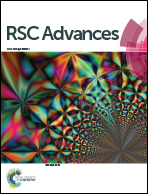One-pot solvothermal synthesis of Cu-modified BiOCl via a Cu-containing ionic liquid and its visible-light photocatalytic properties†
Abstract
Novel visible-light-driven Cu-modified BiOCl uniform sphere-like materials have been successfully synthesized through a one-pot ethylene glycol (EG)-assisted solvothermal process in the presence of 1-octyl-3-methylimidazolium copper trichloride ([Omim]CuCl3). The Cu-modified BiOCl materials were characterized by X-ray diffraction (XRD), X-ray photoelectron spectroscopy (XPS), scanning electron microscopy (SEM), energy dispersive X-ray spectrometry (EDS), Raman, photoluminescence (PL) and UV-vis diffuse reflectance spectroscopy (DRS). The results of the XRD, XPS, SEM, EDS, Raman analyses indicated that metal Cu was evenly distributed on the surface of the BiOCl microspheres in the form of Cu2+. During the reaction process, the metal-based ionic liquid acted as the solvent, the template, the Cl source and the Cu source at the same time. It is possible to tune the morphology of the Cu-modified BiOCl materials by varying the amount of ionic liquid used. In addition, the electrochemical and photocatalytic properties of the Cu-modified BiOCl materials were investigated. After the introduction of Cu2+, the photocurrent of the Cu-modified BiOCl materials was higher than that of the pure BiOCl. And the Cu-modified BiOCl materials exhibited higher photocatalytic activity for the degradation of methylene blue (MB) and bisphenol A (BPA) than that of pure BiOCl. The increased photocatalytic activity of the Cu-modified BiOCl materials was attributed to its large adsorption capacity, broad light absorption band and high separation efficiency of photo-generated electrons and holes. On the basis of these findings, the Cu-modified BiOCl materials showed great promise as photocatalysts for degrading organic pollutants and other applications.


 Please wait while we load your content...
Please wait while we load your content...